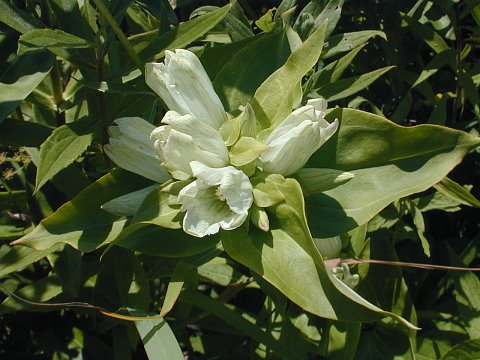Description: This perennial plant is 1-2' tall, with a stout smooth stem that is unbranched. The yellowish or olive green leaves are opposite and strongly clasp the central stem. However, the three leaves beneath the uppermost flowers are whorled. These leaves are broadly lanceolate, ovate, or cordate, and extend up to 3" long and 2" across. There is a prominent central vein, and two side veins that parallel the smooth margins. In the upper half of the plant, 2-7 flowers emerge from the axils of the leaves, with a greater number of flowers at the apex. The tube-shaped flowers are individually about 1½" long and ¾" across, and have 5 petals with small erect tips. They are white, greenish white, or yellowish white, depending on the local ecotype. The blooming period is late summer, and lasts about 1 or 1½ months. There is no noticeable fragrance to the flowers. The seed capsules split into 2 sections, releasing numerous small seeds that can be dispersed by wind or water. The root system consists of a long stout taproot.

Cultivation:
The
preference is full to partial sun, and moist to average soil
conditions. The soil can contain significant amounts of loam, clay,
gravel, or sand. Starting plants from seed can be tricky, while
transplants are much easier to manage. A yellowish appearance of the
leaves is a common reaction to strong sunlight or dry weather, and does
not necessarily signify disease or poor health.
Range & Habitat:
The native Cream Gentian is a rare plant that occurs in scattered
counties in
Illinois (see Distribution
Map). It can be found in mesic black soil prairies, where it
will occasionally form sizeable colonies. Other habitats include the
edges of upland forests, sandy oak savannas, limestone glades, and
rocky bluffs. Populations of this plant may have occurred in other
habitats, such as sand or gravel prairies, but were destroyed before
they could be identified.
Faunal Associations:
Bumblebees are the primary pollinators of the flowers, where they seek
nectar. Some beetles, such as Epicauta pensylvanica
(Black Blister Beetle), have been known to knaw on the flowers.
White-tailed Deer occasionally chomp off the tops of Cream Gentian
plants, but it is not preferred as a food source because of the bitter
leaves (personal observation). The relationship of Cream Gentian to
other mammalian herbivores is not known at the present time.

Photographic
Location:
The photographs were taken at Meadowbrook Park in Urbana, Illinois.
Comments:
This gentian can be easily distinguished from the others by the absence
of blue in the flower. The flowers are not as closed as the Bottle
Gentians (e.g., Gentiana andrewsii), but less open
than the Prairie Gentian (Gentiana puberulenta).
Cream Gentian also blooms about 3 weeks earlier than other gentians.
Because it blends into the background of a prairie quite well, this
plant can be easy to overlook, even when it is in flower. Like many
other gentians, Cream Gentian has an otherworldly beauty that is oddly
attractive. Another scientific name for this plant is Gentiana
flavida.